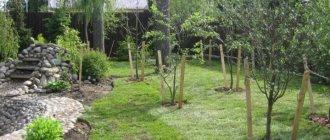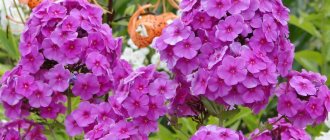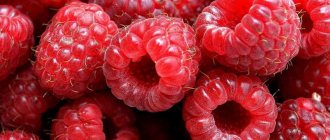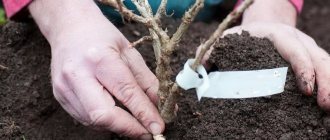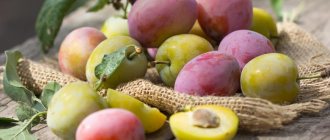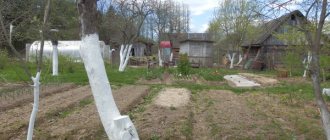Home Country garden
It is no secret that planting trees according to all the rules has a positive effect on their growth, appearance, fruiting and durability. Trees, including fruit trees, are usually planted in autumn or spring. There are separate recommendations for each variety and type. In addition, the planting time is selected based on the regional conditions and climate.
When is the best time to plant trees and why is timing important? Read about this in the article.
- 2 What trees can be planted in autumn?
- 3 Trees that are not recommended to be planted in autumn
- 4 When to plant trees and shrubs in the fall?
- 5 How to choose seedlings of trees and shrubs for planting in the fall?
- 6 How to plant trees in the fall: step-by-step instructions
- 7 Typical mistakes when planting seedlings
- 8 Caring for a tree planted in autumn
- 9 Conclusion
Advantages and disadvantages of autumn tree planting
Many gardeners and landscape designers prefer autumn replanting.
The advantages of autumn transplantation are as follows:
- Most trees and shrubs complete their growing season by fall and slow down their life cycles. Therefore, it is easier to tolerate the procedure itself and take root.
- Seasonal rains nourish the seedlings with moisture and provide them with nutrition for the growth of the root system.
- The roots become stronger, and the tree enters winter already prepared for its new location.
Among the disadvantages of autumn transplants, the following are noted:
- The wrong choice of time for work can lead to illness and death of the seedling. This is affected by weather, precipitation, air and soil temperature.
- Early frosts have a negative effect on seedlings; fragile trees freeze out.
- The bark of young trees planted in autumn attracts rodents (hares and mice), as it is juicy and soft. They eat it, which inevitably leads to the death of the plant.
Fertilizers for spring and autumn planting
When planting in autumn, potassium-phosphorus fertilizer is applied.
Autumn fertilizer.
This can be potassium humate, potassium chloride, superphosphate, or a ready-made “autumn” fertilizer mixture.
The main rule is not to introduce nitrogen-containing mixtures (urea, azofoska, bird droppings, fresh manure) in the fall! This fertilizer causes rapid growth of shoots, which will not have time to ripen before winter and will only draw nutrients from the root!
When planting in spring, on the contrary , nitrogen fertilizer will help the tree quickly grow both roots and branches. It is applied when loosening the tree trunk or by dissolving it in water.
The following drugs are suitable:
- Urea. 15-20 grams per seedling;
- Rotted manure, 1 bucket per seedling. They mulch the top layer of soil at a distance of 10 cm from the plant trunk.
- Infusion of bird droppings in the amount of half a bucket. They need to water the apple tree immediately after planting.
Preparing fertilizer for feeding apple trees
What trees can be planted in autumn?
In autumn, it is permissible to plant young trees that are adapted to a specific climatic zone and have winter-hardy qualities. Of those trees and shrubs that tolerate autumn replanting and the first winter well, the following are distinguished: raspberry, currant, honeysuckle, gooseberry, chokeberry, chestnut, walnut, birch, willow, pine, spruce, juniper, fir, cedar, thuja.
In autumn, it is allowed to plant large trees with a large lump of earth; they tolerate this procedure better.
The video talks about what types of trees can be planted in the fall:
Conditions for planting seedlings
An important condition is a suitable place for growing. Before planting several fruit trees at once, summer residents draw up a plan in which they indicate the height of the trees and the degree of shading of other crops, the type of tree crown, and the period of fruit ripening. It is important that the plants do not shade each other. If the trees are tall, the distance between them should be at least 5 m, if dwarf - at least 3 m.
The area for the tree should be spacious and well lit. A plant with a thick and voluminous crown is planted away from the fence and garden buildings. If the tree is small, several specimens will make an attractive hedge or landscape design element.
There should be no groundwater or swampy areas near the growing site. The root system of most trees does not tolerate waterlogging, so it is better to resolve this issue in advance. A suitable location is hilly and windless, located on the south side of the garden plot.
Tree replanting
Fruit trees are replanted at any time of dormancy - after dropping their leaves in the fall or before the buds open in the spring. It is recommended to replant plants that are at least 20 years old. A common method of transplantation is with an earthen ball. With its help, the plant is less injured and begins to bear fruit faster in a new place. The shape of the coma should be in the form of a cylinder or cube. The procedure is simple: a groove is dug around the trunk at a distance of 50 cm and all horizontal roots are cut off. Then humus is added to the groove.
When transplanting, the tree is removed along with the ground; a tractor or drag sheets are used for this. The plant is placed in a pre-prepared planting hole and watered abundantly. One adult tree requires about 25 liters. In the first year after transplantation, fertilizer is not required. If the plant is damaged during the procedure, apply fertilizer based on ammonium nitrate - 5 g of the substance per 10 liters of water.
Trees that are not recommended to be planted in autumn
Firstly, plants that do not have winter-hardy properties and were brought from warm regions to the north do not tolerate autumn planting well.
Secondly, deciduous plants that shed their cover in late autumn also do not adapt well to a new location in winter. They do not have time to complete the growing season and strengthen the root system. Often their energy is spent on maintaining foliage. Plants that are not recommended to be planted in the fall include plum, pear, apricot, peach, almond, cherry, pyramidal poplar, white acacia, alder, oak .
How to plant an apple tree in autumn and spring?
- Decide on a landing site. One of the common mistakes when choosing a location is close proximity to other trees.
Apple trees on a dwarf rootstock.
For an apple tree grown on a semi-dwarf rootstock (and this is basically all modern seedlings), the distance from other trees should be at least 3 meters. Tall varieties are planted no closer than 5 meters from other trees.IMPORTANT! It is better to choose a sunny place, protected from strong winds, with a groundwater level of at least 3 meters.
- Prepare the planting hole . It is better to do this in advance, 2-3 weeks before disembarkation. To do this, dig a hole 70-80 cm deep and wide. The bottom of the hole is loosened with a shovel so that the earth is more actively saturated with oxygen and it is easier for the roots of the plant to make their way to the moist soil at depth.
- Prepare the seedling for planting. The purchased apple tree must be soaked in water for 4-6 hours in any root formation stimulator (preparations "Epin", "Kornevin", "Heteroauxin", "Kornerost"). Soaking in water will nourish the dried roots, and the use of a stimulant will increase the survival rate of the seedling. Suitable for opponents of industrial drugs folk remedies to accelerate the growth of roots:
- Honey solution. 1 hour l for 2 liters of water;
- Yeast solution 100 grams (small packet) per bucket of water.
- Assess the composition of your soil: is it clay or sandy. The first year the seedling takes root in the planting hole. It is not yet strong enough, and it needs to create optimal conditions for growing. Once established, the apple tree grows on any type of soil, except swampy. If the soil is poor and sandy, add black soil to it. If the soil is heavy, with a high clay content, or simply “packed” virgin soil that has not been cultivated for a long time, add sand to it, 2-3 buckets for the entire planting hole.
- Plant a seedling, following simple rules:
- Before planting, stick a strong peg, metal or wood, into the bottom of the hole. It must be at least 1.5 meters long. 80 cm of them will remain in the hole, and the remaining length will remain outside. You will tie your apple tree to it.
- estimate the depth of planting of the seedling. The grafting site should rise 5-8 centimeters above the ground.
- Pour soil into a heap at the bottom of the hole and place a seedling in the center. Spread the roots of the apple tree in different directions and downwards so that they are not located in one bunch. Fill the hole with prepared soil, lightly pressing it down with your hands.
- water the plant with 3-4 buckets of water.
- tie to the peg in 2 places: top and bottom.
ATTENTION! Before winter, at the first frost, young apple trees are wrapped with covering material - white, translucent material. This needs to be done for the first 3-4 years, until the plant has fully grown.
The planting process in autumn and spring is the same, differing only in the choice of fertilizers applied.
When to plant trees and shrubs in the fall?
The timing of planting trees in the fall depends on the region and weather conditions, on the quality and winter hardiness of the seedling. It is believed that the optimal time for planting will be 3-4 weeks before the onset of frost. During this period, the seedlings will have time to adapt and strengthen the roots, absorb moisture and prepare for winter.
In the Moscow region, the Middle Belt and Central regions, tree planting is usually done from mid-September to mid-October. In the Urals, Siberia, and Leningrad region, it is best to start replanting trees in early September. But the Southern regions may be late with this procedure, carrying it out in October and early November. A warm, long autumn promotes the survival of trees, and the rainy season makes the gardener’s work easier.
Trees are transplanted on a warm, windless day, when there is no bright sun and precipitation. It is best to plant at a temperature of 12-15 degrees Celsius.
In the northern regions, in the fall you can plant cherry, cherry plum, apple, pear, rowan, and plum seedlings that are adapted to frost. Crops such as apricots, cherries, and almonds are best planted in the spring.
How to determine the readiness of a seedling for planting? Pay attention to the leaves. If they turn yellow and fall off, the plant has completed its growing cycle and is preparing for winter. We can begin work.
If the planting time has passed, you should not bury the tree in frozen ground - it will not take root. Leave it until spring, storing it in a convenient way:
- Place it in a cellar or basement. To do this, the roots of the tree should be moistened and immersed in a container filled with sawdust, sand or peat. The air temperature should not fall below zero and rise above 10 degrees.
- Wrap the seedlings in soft cloth and bury them in the snow. The snowing method helps preserve them until spring without much loss.
- Bury the seedling. Watch the video on how to do it correctly.
How to bury a seedling that was not planted on time in the fall:
What types of trees are planted in autumn?
To plant trees and shrubs at the dacha in the fall, gardeners do not use seedlings and crops that are brought from the southern regions. Even with a small amount of snow they die off. The list of permitted crops includes two types of green spaces.
| Winter hardiness | ||
| High | Average | Reduced |
| Cherry | Peach | Almond |
| Apple tree | Cherries | |
| Plum | Apricot | |
| Nut | Willow | |
| Currant | Gooseberry | |
| Conifers | ||
| Chokeberry | ||
On a note! Before purchasing seed, study the description of the variety. It should indicate that it will withstand the cold.
Time is of the essence
The gardener will conduct a successful autumn planting of fruit trees on the site, subject to compliance with the schedule. Garden trees in the middle zone are planted in early autumn. Their list looks like this:
- cherry plum;
- cherry;
- Rowan;
- Apple tree;
- Siberian plum variety.
I plant apricots or peach in the middle zone no earlier than spring. It is possible to shift the procedure to autumn only in the southern regions. If the site is located in the northern region, then planting a fruit tree in the fall is allowed from the beginning of September until the 15th of October. Residents of the southern regions plant from mid-September to mid-November.
If the deadline has passed
It is not always easy for a gardener to meet the deadlines for planting fruit trees in the fall. The procedure to follow in such a situation is as follows:
- a hole is dug in the highest part of the garden;
- a plant is placed in it;
- the hole site should not be surrounded by standing water;
- they dig out the gently sloping southern wall of the ditch;
- height of the northern wall – 0.5 m;
- the northern wall is made vertical;
- the roots of the seedlings are sprinkled with earth;
- the roots of the seedlings are generously watered;
- the roots should not be intertwined;
- seedlings are sprinkled with earth so that only the tips of the branches remain;
- green spaces are covered with spruce branches to protect against pests;
- As soon as full snow has fallen, it is compacted around the tree trunk circle.
As soon as full spring arrives, at your own dacha, seedlings are transplanted from temporary holes to permanent ones. You need to be in time before the first buds appear.
On a note!
It is forbidden to plant fruit trees if a severe winter is approaching. Young seedlings will not survive it. The second rule - the presence of a significant number of pests in the area - is another reason to temporarily abandon planting.
How to choose seedlings of trees and shrubs for planting in the fall?
Choosing a seedling is a serious task, and it should be treated with due attention. The future fate of the plant depends on the quality of the planting material.
It is best to purchase tree and shrub seedlings from specialized nurseries. However, the origin of the plant should be clarified. If it is in a container and has a closed root system, it is quite possible that it was brought from abroad. This means that such a seedling is not entirely suitable for growing in Russia. It is not adapted to climatic conditions and is not ready for the upcoming winter. Even if the seedling survives, it will take a long time to get sick and take root.
Therefore, it is better to give preference to those varieties that were bred in your climate zone and grown in it.
What to look for when choosing a seedling?
- Based on the age of the tree or shrub. It should not be less than 1 year old, otherwise it will not be able to take root in a new place. Well, old trees cannot be replanted.
- Appearance. The bark of the tree should be intact and smooth, of the same color, without inclusions or stains, without damage or signs of disease.
- The roots of the tree should be elastic, not dry, and moderately long. Fruit trees must be grafted.
- The branches are flexible and even. Dry and damaged branches indicate poor quality planting material.
Do I need to use fertilizers when planting?
Autumn planting of trees is carried out with the application of fertilizers and nutrient mixtures. This is done so that the seedlings take root faster and gain strength before the onset of cold weather. Clay soil is diluted with sand, and clay can be added to sandy soil. It is allowed to use peat, humus, rotted bird manure, superphosphate, and potassium salt as fertilizer.
Many gardeners add wood ash to the planting holes.
It is not recommended to apply fresh manure when planting. As it rots, it releases heat that can burn plant roots.
Preparing the pit and seedling for planting
The size of the planting hole depends on the root system of the plant. As a rule, for stone fruit trees it is worth preparing a hole with a diameter of 40 cm and a depth of about 60 cm. For pome trees, the depth of the planting hole should be about 80 cm and the diameter 60-80 cm. If the root system of the plant has grown too large , the size of the planting hole will have to be increased, otherwise the roots will bend inward, and the tree will develop worse and get sick more often.
It is advisable to remove the top fertile layer of soil carefully, without mixing it with the rest of the soil. Subsequently, organic or mineral fertilizers are added to it.
It is recommended to make the bottom of the planting hole well-drained. To do this, you can pour crushed stone with a fraction of 20-40 mm, river pebbles or a sand-gravel mixture.
Before planting, the seedling must be carefully inspected and the root ends, worn out, dry, rotten, frozen and moldy, must be cut off. At the same time, it is important not to get carried away. The size of the root system should match or exceed the size of the crown.
If the roots are very dry, the tree should be placed in a bucket of water for a day.
How to plant trees in the fall: step-by-step instructions
Before planting, you should find out in what conditions the tree will grow and which areas it prefers: sunny or shaded.
Next, you should study the likely size of future trees and determine the size of the crown and root system. Trees should not be planted too close to each other.
Dr. Hessayon D. developed a certain formula for calculating planting holes:
Calculating the distance between tree planting sites
The calculation is based on the sum of the heights of adult plants and divided in half. This figure will be optimal when calculating the distance between seedlings.
Calculation of the distance between shrub planting sites
If you plan to plant shrubs, the sum of the heights of two bushes is divided by 3.
Plant compatibility:
The choice of planting site is based on the requirements of the plant and the capabilities of the site. It is necessary to study how close the proximity of buildings and fences, other plantings, and the groundwater level is permissible. For those trees that do not tolerate high humidity, the groundwater level should not be higher than 1.5-2 meters. Otherwise, there is a risk of root rotting.
Preparation for the transplantation procedure begins with digging a planting hole. The top layer of turf is cut with a shovel and removed. It will be useful later for laying on top or at the bottom of the planting hole. For large trees, the size of the planting pit should be at least 1 m in diameter, for shrubs - 0.6 m.
Next, a layer of earth located under the turf is dug out. It is mixed with sand or clay, fertilizers, peat, ash, and humus are added.
Stages of tree planting
The starting point will be planting a fruit tree on paper in the form of a diagram. The density is selected taking into account the characteristics of the tree’s root system and the factors listed below:
- is it planned to plant trees in a checkerboard pattern;
- the maximum height of each fruit tree;
- the type of rootstock used.
After analyzing the listed parameters, markup is created.
| Rootstock type | Row spacing (m) | Distance between plants (m) |
| Medium low | From 5 to 7 | From 3 to 4 |
| Short | 4,5-5 | 1,5-2 |
| High | 6-8 (pears) | 4-5 |
| 4.5-5 (cherry and plum) | 3 |
When drawing up a diagram, take into account the area that the plant’s root system will require.
| Green space | Area, m2) |
| Apple tree | 72 |
| Pear | 45 |
| Plum | 30 |
| Cherry | 24 |
| Cherries | 20 |
The second rule when drawing up a diagram is that you need to plant nearby trees that are compatible. Newbies should ask themselves two questions. The first is what fruit trees are recommended to be planted in the fall on my site. The second is how they should be positioned.
| What are they planning to plant? | What grows on the site | |||||||||
| apricot | cherry plum | cherry | pear | viburnum | greek nut | peach | plum | cherries | Apple tree | |
| Apricot | + | +/- | — | +/- | +/- | — | — | +/- | — | +/- |
| Cherry plum | +/- | + | +/- | — | +/- | — | +/- | +/- | +/- | +/- |
| Cherry | — | +/- | + | — | +/- | — | +/- | +/- | +/- | + |
| Pear | +/- | +/- | — | + | +/- | — | +/- | +/- | +/- | + |
| Kalina | +/- | +/- | — | +/- | + | — | +/- | +/- | +/- | +/- |
| Walnut | +/- | +/- | +/- | +/- | +/- | + | +/- | +/- | +/- | +/- |
| Peach | +/- | +/- | — | — | +/- | — | + | +/- | — | +/- |
| Plum | +/- | +/- | — | — | +/- | — | +/- | +/- | — | +/- |
| Cherries | +/- | +/- | + | +/- | +/- | — | +/- | +/- | + | + |
| Apple tree | — | +/- | — | + | — | +/- | +/- | + | — | + |
The “+” sign indicates 100% compatibility, “-” indicates a ban on joint planting, and “+/-” means there is a slight likelihood of mutual hostility developing.
Choosing a landing site
The practical stage of planting fruit trees in the fall in the Moscow region begins with choosing a location. We are talking about a flat surface. Tall and low-growing varieties are positioned so that they do not block the light. In areas where there is not enough free space, seedlings are planted, leaning on the shade of the tallest green space. The third rule is that it is prohibited to use areas with high groundwater levels.
On a note!
The landing site is located 4.5 m further from the water supply.
Soil preparation
Proper planting of fruit tree seedlings on a site in the fall begins with choosing the diameter of the hole. They start from the standard - 40 cm (diameter) and 60 cm (depth). If you plan to plant seed crops, then the size of the hole is 80x80 cm. It is better to plant fruit trees on the site yourself, taking into account the recommendations listed below:
- if the seedling does not fit into the hole, then it needs to be enlarged rather than cutting off the roots;
- the bottom of the pit is sprinkled with a layer of crushed stone, pebbles, fine gravel - 40 mm;
- when removing the top layer, be careful;
- organic matter or mineral fertilizers are added to the top layer.
After planting, the seedling needs time. Over the next 24 months, its source of nutrition will be the substances it receives from the soil.
Preparing seedlings
For planting seedlings in the fall, specimens with a developed root system are selected. If there is minor damage to the roots or branches, they cannot be used. As a last resort, prune the seedling to a healthy area. If the gardener decides to plant seedlings with cut roots on the plot, the harvest may be smaller. The minimum length of the main root is 35 cm or more. You can’t take less, otherwise you won’t be able to reap the harvest. The second condition is the presence of a large number of branches from the main root.
Disembarkation
A peg is placed at the bottom of the dug hole. It is necessary to create a guide. The next stage is straightening the roots of bushes or trees. They are covered with a “slide” of nutrient mixture:
- 1 kg of rotted manure;
- 1 kg of fertile soil;
- For 1 pit I use up to 30 kg of mixture.
It is better to plant fruit trees on the site in the fall without using fresh manure. Summer residents who plan to plant trees on clay soil can improve its characteristics. Replanting will not be required in the spring if you add a mixture of 3 buckets of peat and 3 buckets of humus to the hole. The layered “pie” is covered with 2 buckets of river sand.
Typical mistakes when planting seedlings
There are mistakes that are made when planting trees. They slow down growth and survival rate and increase the risk of tree death.
- The tree was planted too high. The root system is close to the surface of the earth. It runs the risk of being dried out, frozen or burned in the sun.
- The tree was buried too deeply and the root collar was covered. The tree will most likely stop growing and die.
- The roots of the tree were not straightened down. They will begin to grow incorrectly and the tree will not be able to take root.
- Too much fertilizer can burn the root system and negatively affect the growth of leaves and new shoots in the spring.
- A lack of nutrients will slow down the growth of the tree, weaken the immune system and allow the development of diseases and pests.
When to plant fruit trees: autumn or spring
In spring, all the flora begins to grow, and it seems that spring is the best time for planting. If we are talking about seeds, then yes. Although there are some nuances here too. But it is better to plant young trees in the fall. The advantage of planting fruit trees in autumn is that the plant wakes up in a new place. The roots begin to grow in the soil undisturbed by anyone. If one season is lost when planting in the spring, then when planting in the fall the tree will have time to get comfortable in the soil and will quickly grow in the spring.
The main argument of opponents of planting in autumn is that the seedling will freeze in winter. This can actually happen if;
- landing was carried out incorrectly;
- a southern variety of tree was planted before winter in the northern region;
- the tree was planted before the onset of the dormant period;
- in an open root system, the roots are frozen or dry.
But similar arguments can be made against planting in the spring. The planting time this season is very short: you need to catch the moment between the soil thawing and the start of sap flow. And it is unlikely that the plant will have time to recover from the change of residence before the start of the active growing season.
When planting in spring, the roots of plants are often dry, but few gardeners pay attention to this. And against winter freezing, supporters of planting in the fall have little tricks.
Caring for a tree planted in autumn
After planting, the tree only needs watering and loosening. Watering is done once a week, provided there is no precipitation. 2-3 buckets of water are poured under each tree. Watering is done at the root.
Loosening is carried out once every 10 days in order to break up dry crust or lumps that prevent oxygen from reaching the roots.
If the rainy season begins, artificial irrigation is stopped.
For the winter, the tree is protected from snow and rodents. For these purposes, you can use cardboard and covering material, which should be removed in early spring.
Proper care
Seedlings transplanted to a permanent location must be properly processed. The root collar is positioned so that after planting it is above ground level. The soil should not touch it. The second rule is that each green space has a specific degree of deepening. For example, apple and pear trees can be planted on the site in the fall, provided that the root collar rises above the ground to a height of 6 cm.
On a note!
A stick with marks on it will help you maintain the planting height. It is temporarily inserted into the hole.
Regular watering
Gardeners make a mistake. While some save, others do not spare water. Once you find out what trees your neighbors plant on their property in the fall, it’s a good idea to clarify the watering rules. Residents of the northern regions bring in 1 bucket, the central ones - 2, and the southern ones - 3 buckets of water after planting is completed. Further moisture depends on the climatic characteristics of the region. With moderate humidity during autumn, watering is carried out once every 20 days. If weather forecasters promised a rainy season, then the initiative is left in the hands of Mother Nature.
You can't rush to whitewash
Botanists advise choosing trees that do not have smooth bark, which are best planted in the fall. They can be whitened regardless of weather conditions. The situation is more complicated with varieties that have perfectly smooth bark. They cannot be whitewashed. The prohibition applies to branches and trunk.
You may be interested in:
Fruit seedlings from Moscow nurseries: where to buy There is no need to even doubt that only a healthy seedling of a correctly bred variety can ultimately grow...Read more...
Care in the first year after planting
During the first year of plant life, they require constant care. While the tree or bush is young, formative pruning needs to be done.
Feeding is carried out at intervals of 18…25 days. In this case, part of the fertilizer is sprinkled in the near-trunk part. Foliar feeding is useful, which is performed by spraying a solution containing:
- 15...25 g of nitrogen fertilizers (mainly urea);
- 20...25 g of phosphate fertilizers (superphosphate);
- 12...15 g of potassium fertilizers (potassium salt).
All mineral fertilizers are dissolved in 10 liters of water, then applied to a bush or tree using a garden sprayer.
- From the first ten days of June to mid-July, fertilizing with chicken droppings is useful.
- Place 200 g of chicken manure in a 20 liter bucket.
- Insist for at least five days.
- Filter the liquid. Solid inclusions can be buried at some distance from the root (1...2 m).
- The liquid is diluted in a ratio of 1:20.
- The tree trunk circle is watered with it. Approximately 10 liters per large tree and 5 liters per bush.
Planting fruit trees in summer
Fruit tree pests
Among modern summer residents there are those who do not like following stereotypes. They also practice planting garden trees in the summer. Moreover, at the present time this can actually be done without harming the trees.
Previously, the argument against the summer period was hot weather, which prevented normal rooting. But then the seedlings were sold exclusively with an open root system, which, indeed, is more comfortable to take root at low temperatures in well-moistened soil.
Now nurseries sell trees in containers with soil mixture, and it is no longer so important for the plant at what temperature it is sent into the hole. The roots are quite well protected and do not dry out.
soil mixture
If an automated standardized irrigation system is installed on the site, then summer is even preferable for planting. June is considered a suitable month. You need to choose days based on the phases of the moon. You should wait until the second or third quarter of the night's activity to plant fruit tree seedlings.
The soil temperature is also taken into account. If it is above 25 degrees Celsius, planting work in summer should be carried out either early in the morning (at 6-8 o’clock) or late in the evening, but before sunset. This will save the root system from burning and allow the plant to adapt better.
Experienced gardeners highlight the following advantages of summer tree planting:
- you can choose suitable planting material without haste - in summer there is no such influx of farmers in nurseries;
- during the growing season it is easier to evaluate all the advantages of purchased trees;
- seedlings planted in summer have time to take root before the cold weather and are more resistant to winter than those planted in autumn.
Important! In order for young trees to withstand winter frosts, during summer planting, all ovaries that appear on the plant should be removed. Otherwise, they will take excess juices from the seedling and weaken it.





